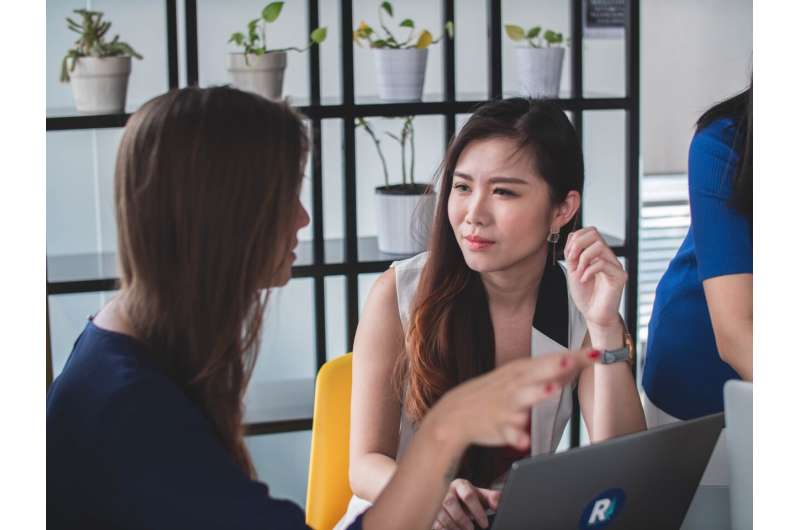This article has been reviewed according to Science X's editorial process and policies. Editors have highlighted the following attributes while ensuring the content's credibility:
fact-checked
peer-reviewed publication
trusted source
proofread
Examining the experiences of anti-Asian racism among medical students

Experiences of anti-Asian racism and feelings of invisibility are common among Asian American medical students, according to a Yale-led study based on interviews with students at more than a dozen schools in the U.S. The experiences, say the researchers, highlight the need to establish a more inclusive medical school learning environment.
The study was published Sept. 11 in the journal JAMA Network Open.
In 2020, Dr. David Yang, who is now a fellow in the Department of Emergency Medicine at Yale School of Medicine, experienced an instance of COVID-19-related racism. While soon thereafter it would become clear that the emergence of COVID-19 had brought with it an increase in anti-Asian racism throughout the United States, at the time Yang wondered whether what he had experienced was a standalone instance or an example of something more widespread.
After finding little research on anti-Asian racism in the medical school environment, he decided to study it himself.
In the new study, Yang and his colleagues interviewed 25 Asian American medical students studying at 17 schools in the United States and looked for common themes in their discussions. The interviews focused on the students' experiences with microaggressions and racism, the types of support their medical schools offered, and how the students thought schools could improve the learning environment.
"We wanted to make sure we had a broad range of perspectives," said Yang, who was lead author of the study. "So we intentionally recruited students who are classically less represented in medicine, such as Vietnamese Americans and Filipino Americans, in addition to those who are more visible like Chinese Americans and Indian Americans."
In most cases students reported experiences of racism, such as accusations by patients that they or their colleagues had COVID-19 because they were Asian and an attending physician who joked that a Pakistani American medical student was associated with the Taliban.
Many of the students also reported feeling "invisible," both on a personal level—being mistaken for other Asian American students, for example—and more broadly, as many ethnicities are often lumped together as "Asian." Students also felt their identities were invisible within their medical school curricula, which had little or no references to the specific needs of Asian American patients.
The collective experiences along with a lack of institutional support led students to feel isolated and exhausted, the researchers report.
"The students described themselves as not being able to work or focus, unable to even think about medicine because of these constant racist experiences that kept appearing during their training," said Yang. "I know from my own experience that this type of environment can lead to a lot of mental health problems, burnout, and, at the very worst, suicide attempts and deaths by suicide."
Some students in the study reported suicidal feelings as well and some questioned whether it was worth continuing their medical training. Along with the effects this has on individuals, it can also influence workforce diversity, said Yang.
"Asian Americans as a whole would be considered overrepresented in medicine based on the population of the United States, but there are more than 17 different populations represented within the umbrella term of 'Asian American,'" said Yang. "Some of those populations may indeed be overrepresented, but there are so many communities that aren't represented at all, and that can affect the Asian communities we treat."
Yang notes that this study focuses on the Asian American population and that addressing these challenges should not be at the expense of other underrepresented communities.
The students interviewed offered suggestions for improving the medical school learning environment for Asian American students, including disaggregating Asian ethnicities in the admissions process, including lectures on Asian American health in curricula, and increasing Asian American representation among leadership and mental health personnel.
"It's important to have mental health personnel that really understand racialized experiences," said Yang. "Students said they felt most heard when they had a therapist that was either knowledgeable about or was open to talking about racism."
Yang suggests medical school administrators also talk to their Asian American students, ask how the school can better support them, and then provide that support.
"Among a diverse group of Asian American medical students, discrimination during medical training took on many forms from daily microaggressions to acts of overt racial aggression, which increased during the COVID pandemic," said Dr. Gunjan Tiyyagura, associate professor of pediatrics at Yale School of Medicine and senior author of the study.
"Yet students described numerous barriers to feeling supported or visible. This study is the first to delineate practical strategies that institutions can pursue to start mitigating the invisibility felt by many students and addressing discrimination during a formative period for students."
More information: David H. Yang et al, Experiences with Racism Among Asian American Medical Students, JAMA Network Open (2023). DOI: 10.1001/jamanetworkopen.2023.33067
Journal information: JAMA Network Open
Provided by Yale University




















